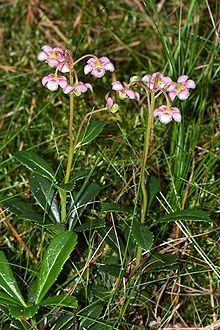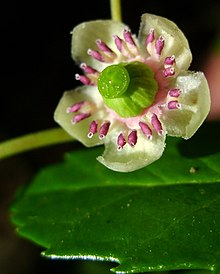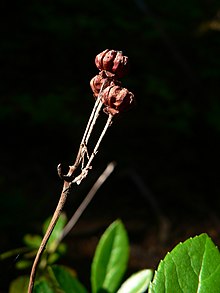| Chimaphila umbellata | |
|---|---|

| |
| Scientific classification | |
| Kingdom: | Plantae |
| Clade: | Tracheophytes |
| Clade: | Angiosperms |
| Clade: | Eudicots |
| Clade: | Asterids |
| Order: | Ericales |
| Family: | Ericaceae |
| Genus: | Chimaphila |
| Species: | C. umbellata
|
| Binomial name | |
| Chimaphila umbellata | |
Chimaphila umbellata, the umbellate wintergreen, pipsissewa, or prince's pine, is a small perennial flowering plant found in dry woodlands, or sandy soils. It is native throughout the cool temperate Northern Hemisphere.
Description[edit]
This plant grows up to 35 cm (12 in) tall, with one simple stem bearing evergreen, shiny, toothed leaves in opposite pairs or whorls of 3-5 (and sometimes more) along the stem. Leaves have a slightly spiny serrulate margin starting close to the base, and range from 1 ½ to 2 ½ inches long (or longer) with a typically oblanceolate shape. Flowers range from white to pink, produced in a small umbel of 4–8 together. The filaments have a roundish expansion at the base, bearing hairs along the margin only. In comparison, the closely related C. menziesii bears hairs on the back of the filament's expansion as well.[2]


Ecology[edit]
Although it has green leaves year-round, it receives a significant portion of its nutrition from fungi in the soil (that is, it is a partial myco-heterotroph, which is not surprising as related plants, such as Pyrola, are partial or full myco-heterotrophs).[3]
Taxonomy[edit]
There are four subspecies:
- Chimaphila umbellata subsp. umbellata – Europe, Asia
- Chimaphila umbellata subsp. acuta – southwestern North America
- Chimaphila umbellata subsp. cisatlantica – northeastern North America
- Chimaphila umbellata subsp. occidentalis – northwestern North America
Uses[edit]
Some Plateau Indian tribes used a boil of prince's pine to treat tuberculosis.[4]
The twentieth century Appalachian folk healer Clarence "Catfish" Gray, "Man of the Woods", credited pipsissewa with curing his own heart problems and included it in his 15 herb cure-all "bitters."[5]
It can reportedly be used as a flavoring in candy and soft drinks, particularly root beer.[6]
The roots and leaves of Chimaphila umbellata can be boiled to create tea.[7]
Recent investigations show the anti-proliferative effect of Chimaphila umbellata in human breast cancer cells (MCF-7). [8]
Name[edit]
"Pipsissewa" is a Cree name meaning "It-breaks-into-small-pieces".
References[edit]
- ^ NatureServe (2024). "Chimaphila umbellata". Arlington, Virginia. Retrieved 28 March 2024.
- ^ Jepson, Willis Linn. "A Flora of California". ucjeps.berkeley.edu. University of California, Berkeley. pp. 47–48. Retrieved 2023-07-27.
- ^ Leho Tedersoo; Prune Pellet; Urmas Kõljalg; Marc-André Selosse (March 2007). "Parallel evolutionary paths to mycoheterotrophy in understorey Ericaceae and Orchidaceae: ecological evidence for mixotrophy in Pyroleae". Oecologia. 151 (2): 206–217. Bibcode:2007Oecol.151..206T. doi:10.1007/s00442-006-0581-2. PMID 17089139. S2CID 12529846.
- ^ Hunn, Eugene S. (1990). Nch'i-Wana, "The Big River": Mid-Columbia Indians and Their Land. University of Washington Press. p. 352. ISBN 978-0-295-97119-3.
- ^ Green, E. (1978). "A Modern Appalachian Folk Healer". Appalachian Journal. 6 (1): 2–15.
- ^ "Chimaphila umbellata". www.fs.usda.gov. Retrieved 2023-07-28.
- ^ Patterson, Patricia A. (1985). Field Guide to the Forest Plants of Northern Idaho (PDF). United States Department of Agriculture Forest Service. pp. 37–47.
- ^ Das, N., Samantaray, S., Ghosh, C., Kushwaha, K., Sircar, D. and Roy, P., 2021. Chimaphila umbellata extract exerts anti-proliferative effect on human breast cancer cells via RIP1K/RIP3K-mediated necroptosis. Phytomedicine Plus, p.100159.
